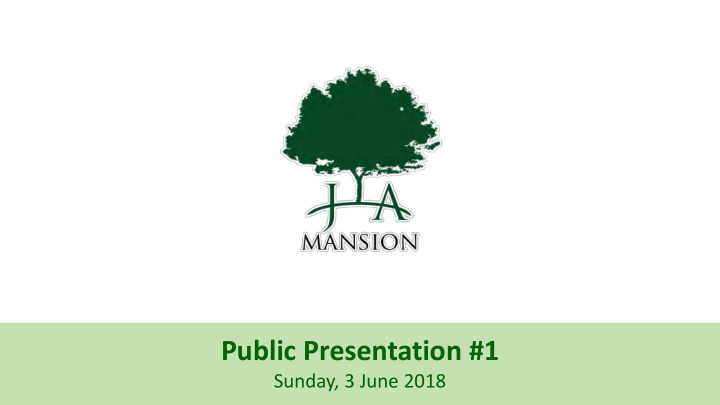



Public Presentation #1 Sunday, 3 June 2018
What’s up? - James Arnold Mansion, Inc. Landscape Master Plan - brief site history and overview of our process to develop a Landscape Master Plan for its rehabilitation. Public Input - comments, concerns, questions, thoughts, and ideas. House Tours – for those who are new to the Arnold Mansion or those who wish to see it again. Today’s Program
• Since 1919, building and grounds owned and occupied by the Wamsutta Club. • In 2016, the James Arnold Mansion, Inc. (JAMI), was created and acquired the building and grounds from the Wamsutta Club. • Since then Wamsutta Club occupies portions of the ground floor as a tenant of JAMI and carries on its activities independent of the mission and functions of JAMI. • And, JAMI is responsible for the preservation and restoration of the building and grounds consistent with its mission to achieve public benefit in the spirit of James Arnold and his wife Sarah through educational programs. The James Arnold Mansion , home of the Wamsutta Club
How did we get here?
1821: The Arnolds bought 11 Acres at Union and County streets
And built a simple but substantial House
1868: Wm. Rotch inherited the property and enlarged the house
Making it even more substantial
1919: the Wamsutta Club bought the property and made changes
That we still see today
1821: The Arnolds built a simple Federal style house for a Quaker family of three. 1870s: Wm. Rotch enlarged and added the third floor for his family of nine and changed the aesthetic to a French Empire style. 1919: The Wamsutta Club saved and converted it into the building we know today. 2018: JAMI’s goals are to preserve the building as is, address the demands of deferred maintenance, make it more accessible, and promote educational uses. And, be inspired by the Arnolds’ dedication to landscape, horticulture, and public good to guide our next moves regarding the grounds and educational programs. James Arnold Mansion - Period of Significance?
James and Sarah Arnold took great pride in their gardens and shared them with the citizens of New Bedford before there were any public parks. James was a co-founder of the New Bedford Horticultural Society. When each died, bequests were made to the city for the long term benefit of the poor. When James died, he left funds to advance the study of horticulture that were later combined with land previously left to Harvard University that together became the world-famous Arnold Arboretum in Jamaica Plain. We hope to recreate some of the landscape experiences of the Arnolds’ garden. Benefactors and Gardeners
1821: 11 acres with a house – but, what about the grounds?
In 1841, Andrew Jackson Downing described the Arnold gardens
Literature review suggests that some inspiration came from the hedge and maze gardens at Hampton Court in England
Grotto in the Grounds of James Arnold, Esq., New Bedford “Shell House” on the Arnold Estate A. J. Downing, 1841 Date / exact location unknown - Spinner And, the idea for this garden grotto may have come from their trip to Italy in the 1830s
Location, location, location
A view down Spring Street to the Harbor
Environmental Context
A possible Landscape Response
A. J. Downing included this diagram of an ideal private landscape in his 1841 book, The Theory and Practice of Landscape Gardening
Comparing the Arnold property and Downing’s plan suggests that what the Arnolds had done earlier may have influenced others.
Start conversations • Inventory and with other city evaluate. groups concerned • Prune and remove about their trees. deadwood. • Remove diseased Goals - enhance our trees. city’s urban forest • Protect against and recognize pests. important private • Improve soil and and public trees. roots. First Step - Care for our trees
Possible other Arnold trees on neighbor properties.
Challenges - JAMI Site 2.89 Ac Uses Building 0.35 Ac 12% Parking Paved 1.10 Ac 40% Security Landscape 1.44 Ac 48% Accessibility Parking 104 spaces (5 HC) Challenges - City Missing sidewalk Missing trees Step 2 – Identify what we have
? What would you like to see happen here? Step 3 – Seek input, Assess regulations, and then - Propose options
We welcome your comments Thank you for listening
Recommend
More recommend